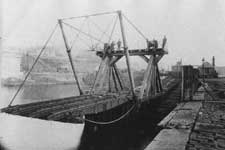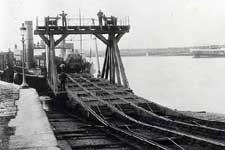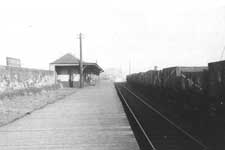The train ferries
On this page
Outline history
The railway network in Great Britain expanded rapidly in the 1840s. That was the period when most of the main long-distance lines were constructed, many of which are still operating today. London and Edinburgh were connected by rail via Newcastle and York in 1850 following the completion of a railway bridge over the Tyne in August 1849 and the so-called Royal Border Bridge over the Tweed at Berwick in August 1850. For a few years previously the rail journey was in stages with horse-drawn vehicles making the cross-river connections at these points. This route became known as the East Coast Main Line (ECML). A longer route via Carstairs and Carlisle had opened in 1848, the West Coast Main Line (WCML). This line branched at Carstairs, with most of the trains going to and from Glasgow.
The obvious next step was to extend the route northwards to Dundee and Aberdeen. But there was a problem – the direct route would involve crossing two major estuaries, the Firth of Forth and the Firth of Tay. An alternative, much longer, route was possible via Stirling and Perth, and that line was built.
For details of the railway history in the area, please see our page about Railways and Granton.
Bridge technology in the 1850s was not sufficiently well developed to allow these firths to be crossed, and the finances of the railways at the time, which were mainly fairly small and locally based, would probably not have made bridges possible in any case. (Even in the 1880s the Forth Bridge was jointly financed by four companies.) So another answer had to be found. Passenger traffic was not the main issue. Passengers were apparently willing to accept short ferry trips with most of the journey being by train – no doubt that was greatly preferable to a sea voyage from Granton or Leith to Aberdeen or, even worse, a journey by road. The real problem was goods traffic, as trans-shipment of goods from train to boat and boat to train was slow, labour-intensive and risked damage to the consignments.
An answer was found in the form of the 'Floating Railway' devised by Thomas Bouch![]() .
.
Thomas Bouch was then an enterprising young engineer, and had been involved previously with railways. He designed many successful structures but unfortunately later was responsible for the first Tay Bridge which collapsed in a storm in 1879. Much has been written about that – the most charitable explanation is that he was misled by wrong information given by the Meteorological Office about wind speeds, and let down by poor working practices during construction. More information about the Tay Bridge Disaster![]()
His proposals for Granton to Burntisland crossing were to have special vessels built with railway lines on the decks and matching equipment provided at the harbours at each end of the crossing to allow wagons to be run directly on and off the vessels. The crossing was approximately five miles, from Granton to Burntisland, almost due north / south. A railway from Edinburgh city centre to Granton already existed, and a line ran from Burntisland to Ladybank where there was a junction, one route going to Perth and the other to Tayport (Ferryport-on-Craig) where a further ferry crossed the Tay.
Granton Harbour was built and owned by the Duke of Buccleuch; the existing port of Burntisland![]() was developed by the Duke and Sir John Gladstone
was developed by the Duke and Sir John Gladstone![]() .
.
The map above shows the harbour just after the train ferries stopped operating. The ferries berthed on the east side of the Middle Pier near to where the words ‘Granton Station (Terminus)’ are shown. The map may not open at full size – it is set to fit within your browser window. To enlarge it further, click the icon near the bottom right of the image.
The proposal was accepted and work went ahead. The actual design of the ferries appears to have been by Thomas Grainger![]() , a partner in the firm of Grainger and Miller, railway engineers, who were involved in the design of the railway between Edinburgh (Scotland Street
, a partner in the firm of Grainger and Miller, railway engineers, who were involved in the design of the railway between Edinburgh (Scotland Street![]() ) and Granton. The ferries operated successfully from 1850 onwards, generally without any problems, although the crossings were suspended in very rough weather. This was the first roll-on/roll-off train ferry in the world and was withdrawn only in 1890 when the Forth Bridge, further upstream, was completed along with substantial new railway lines to connect it to the rest of the railway network.
) and Granton. The ferries operated successfully from 1850 onwards, generally without any problems, although the crossings were suspended in very rough weather. This was the first roll-on/roll-off train ferry in the world and was withdrawn only in 1890 when the Forth Bridge, further upstream, was completed along with substantial new railway lines to connect it to the rest of the railway network.
The vessels themselves and the shore installations were dependent on each other, and purpose-designed.
Both at Granton and Burntisland, the slipways were constructed to allow the vessels to be loaded and unloaded at all states of the tide. This was accomplished in two ways – firstly the gantry structures could be moved up and down the slipways, and secondly there were ramps, which could themselves be moved, to connect the shore side to the vessels. Stationary steam engines powered ropes on pulley wheels between the rails to pull wagons on and off the ferries.
Vessels
The ferries were owned by the railway company, which referred to them as 'Goods Boats'.
- The first and best-known was the Leviathan (sometimes spelt Leviathon), built on the Clyde by Robert Napier & Sons
 in 1849 – 399 tons. The vessel was double-ended, had two paddles, each driven by a separate steam engine each with its own funnel, and had two lines of rails on the deck.
in 1849 – 399 tons. The vessel was double-ended, had two paddles, each driven by a separate steam engine each with its own funnel, and had two lines of rails on the deck. - In 1850, the Robert Napier was built and was similar but slightly smaller – 243 tons.
- The Balbirnie was added to the fleet in 1851, named after one of the directors of the company, Balfour of Balbirnie.
Vessels added subsequently were:
- Kinloch, built in Glasgow, 585 tons, entered service 1865
- Midlothian, built in Leith in 1881 – 920 tons
A further train ferry, the Carrier, was built in in 1858 for the Tay crossing.
The service became quite intensive, the Balbirnie in 1863 operating day and night with two crews each working 12 hour shifts. Wagon capacity was 20 on the Leviathan, and 40 on the Midlothian. Although the service was for goods wagons, empty passenger carriages and occasionally locomotives were conveyed, as the ferry was the most convenient way of transferring stock to the different parts of the railway system. The alternative was to send them by rail over other companies' lines which would have incurred charges.
Passengers were catered for by more conventional vessels, the ‘Passenger Boats’, all paddle-steamers. These included from 1848:
- Granton
- Burntisland
- Forth
And fairly soon after that:
- Auld Reekie
- Thane of Fife
- Express
In later years, many other vessels carried passengers on the crossing, the best-known being the William Muir (named after a director of the railway company).
Shore installation
The shore installations, both at Granton and Burntisland, consisted of an evenly graded stone slipway with rails laid down it – in addition to the tracks for the wagons, there were also rails which carried a moveable framework with a link span or ‘floating bridge’. The whole framework could be moved up and down the slipway to suit the tides and the hinged link span accommodated any movement of the vessel in the water.
There does seem to have been a change of gradient on the tracks where these sections met, but as the railway vehicles at the time normally had only four wheels rather than the bogies used in later years, this presumably was not a problem.
An interesting feature was that the rails on the vessels were arranged so that the four rails could be used either as two parallel tracks or as a single track, using the centre two rails only. This was done by setting the rails so that they were all guaged at 4’ 8½” (1435 mm) apart – normally double track would have the running rails at that guage, but the two tracks a little further apart. This allowed one line wagons to be placed centrally on the ferry to balance the vessel if there was only a part load to be taken across the Forth. Special pointwork was needed on shore to accommodate this.
Small locomotives were stationed at Granton and Burntisland to shunt wagons at the ferry terminals, including for some years members of a small class of 0-6-0 saddle tanks designed by Thomas Wheatley![]() .
.
Adjacent to this facility were passenger stations – a fairly modest wooden station on the Middle Pier at Granton, and a much more substantial stone station at Burntisland. Passengers therefore had only a short walk from the train to the passenger ferries.
The end of the train ferries
After the Forth Bridge opened in March 1890, the goods boats were withdrawn and the passenger boats on the Granton-Burntisland crossing lost custom. The goods boats, and two of the passenger boats, were disposed of. John Thomas, in ‘The North British Railway Volume 2’ quotes from the North British Railway Minutes of 17 August 1890:
‘Forth steamers sold for scrap to P & W McLellan, Glasgow.
| Goods vessels | Sale price |
|---|---|
| Midlothian | £6,750 |
| Leviathan | £1,200 |
| Balbirnie | £1,875 |
| Kinloch | £1,875 |
| Passenger vessels | Sale price |
|---|---|
| Thane of Fife | £1,000 |
| Auld Reekie | £1,000 |
Haulage machinery at Burntisland and Granton sold for £17,250.’
Granton Station was closed to passengers in 1925. The original station at Burntisland was superseded by adjacent platforms at a higher level, on a new curved line built to connect to the Forth Bridge via Aberdour and Inverkeithing. The original stone building has survived.
Following the success of the Granton – Burntisland train ferry, many others were constructed. One of the best known for many years was Dover-Dunquerque, which did carry passengers in trains, using sleeping cars built by the Compagnie Internationale des Wagon-Lits. The carriages (but not the locomotives) were shunted onto the ferry, which had rails on one deck just like the Granton-Burntisland ferries, and taken off at the other end to continue their journey by rail. For the voyage, they were chained down.
There were also numerous train ferries for goods vehicles around the world. There is more information on Wikipedia![]() .
.
Further information
If you are would like to know more about the Granton – Burntisland train ferries, you may find the following books interesting:
| Title | Author | Publisher | Date | ISBN |
|---|---|---|---|---|
| The North British Railway Volume 1 | John Thomas | David & Charles | 1969 | 0715346970 |
| The North British Railway Volume 2 | John Thomas | David & Charles | 1975 | 0715366998 |
| Burntisland – Fife’s Railway Port | Peter Marshall | Oakwood Press | 2001 | 0853615780 |
John Thomas’s books have been out of print for some years but you may find them in the library or online![]() ... Volume 1 contains a colour picture of locomotive No 224, which went down with the Tay Bridge but was salvaged and ran until 1919, being known to the crews as ‘The Diver’.
... Volume 1 contains a colour picture of locomotive No 224, which went down with the Tay Bridge but was salvaged and ran until 1919, being known to the crews as ‘The Diver’.





